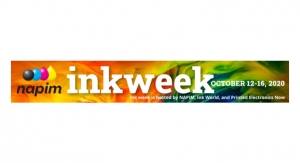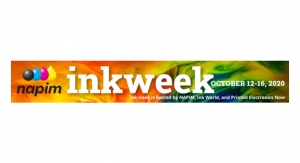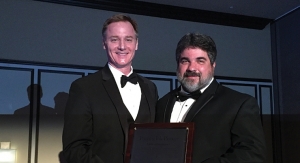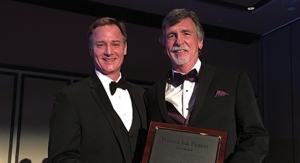|
The words “Occupational Safety and Health Administration” may not mean much to the general public, but its acronym, OSHA, is enough to strike terror into any unprepared business.
“I’ve had frantic calls from people who had OSHA inspectors outside,” said Gary Reniker, INX International’s director of safety and 29-year veteran of the ink industry. “I couldn’t even recognize their voices.”
While OSHA has been affected by budget cuts, that does not mean the agency is fading away. Rather, in the past year and a half, 13 ink facilities were inspected.
“The chance of inspection works out to once every 20 years, but it’s random,” Mr. Reniker said “This is a panic experience if you have ever had an OSHA inspection.”
“You can’t rely on statistics when the inspector comes to the door,” said George Fuchs, NAPIM’s environmental affairs manager. “You better be in compliance.”
Accidents and The Ink Industry
While the ink industry has had accidents over the years, industry leaders said that it is relatively safe by manufacturing standards.
“The ink industry is a relatively small industry and a very complex process, and inspectors don’t have the time to really understand what it’s about,” Mr. Fuchs said. “I would say that the ink industry is safer than most industries and has a relatively low hazard rate.”
Lisa Glass, Wikoff Color’s corporate health, safety and environmental coordinator, said that there are potential dangers for employees.
“In terms of physical hazards, are there potentials for accidents?” Ms. Glass asked. “You have mixing and rotating parts, heating processes, and depending on your product line, you may have other problems. You have to get the training and knowledge levels up.”
OSHA has had force reductions over the years, and there are fewer inspectors. However, that’s not to say that OSHA will not visit; it just means that OSHA tries to focus most of its energies of specific circumstances.
“The first thing that triggers a visit is either a fatality, an accident that involves more than three employees or an employee complaint,” said Dennis Sankot, regulatory compliance manager at Color Converting Industries.
“A fatality will guarantee an inspection,” said David Currier, safety and industrial hygiene specialist with Flint Ink. “An employee complaint depends upon how it is written up. It could be handled by correspondence. OSHA now requires that employee complaints be signed.”
When OSHA Visits
What happens when OSHA walks through the door?
“OSHA is looking for documentation, an organized safety policy manual that includes applicable administrative programs, training materials, and documentation of trained personnel,” said Carl Raycroft, PE, divisional engineering manager, environmental and safety for Sun Chemical’s GPI division. “The manual should demonstrate an organized safety program that is user friendly, easy to reference, accessible to all employees, and inclusive of all potentially applicable regulations.”
A clean, organized working environment is also helpful. “OSHA inspectors are spread thin,” said Mr. Raycroft. “The easier it is for them to verify compliance, the less likely they will question the safety efforts of the facility. In addition, a clean facility goes a long way in describing the facility’s work ethic and culture. Not only is a clean facility an important safety factor (i.e. less trip, slip and fall hazards), but the perception is that the facility management and employees are dedicated to maintaining a fresh, safe work environment.”
Knowing your rights and responsibilities are critical before OSHA comes for an inspection.
“You have to know your rights and responsibilities, so you know what you have and don’t have to show them or share with them,” Mr. Currier said. “You have to understand that they are doing their job and their intent is to help you. At a bare minimum, OSHA will want to see your injury and illness log and your Hazard Communication or Right-To-Know program, so be prepared to have those up to date.”
“The first thing they do is ask questions about the operation,” Ms. Glass said. “They will ask you if you have a HazCom plan, training programs and fire evacuation programs.”
Knowing what OSHA can and cannot ask for is important for all companies.
“First, you need to know what regulations apply to your company,” Ms. Glass said. “Second, you have to make sure all of your employees are trained in those regulations, and third, you have to manage in a way that ensures they are complying.”
A company can avoid OSHA violations by being organized and careful.
“What typically trips companies up is not keeping programs up-to-date,” Mr. Fuchs said. “A new hazardous chemical might be used, for example. Second is the training of new hires on what the hazards are in the work place, such as a new process or a new chemical. OSHA will go out and find an employee who is working and ask them what the hazards are. If the worker says he doesn’t know that, it’s a violation.”
“The person in charge of the facility has to answer questions honestly, but does not have to show them what they don’t ask for,” Mr. Currier said. “A good inspector will try to ask you a question in different ways, to ensure full communications (to account for nicknames and abbreviations).”
People have to be careful what they tell OSHA. “OSHA inspectors listen to what you say. Be careful about letting your mouth overrun or providing orchestrated machine demonstrations,” Mr. Reniker said. “I have a safety coordinator at each facility that I train on all the specifics of what to do in case an OSHA inspector comes in. This training eases the panic and allows them to know specifically what to do.
“A lot of people don’t really know the regulations, and it can sometimes get technical,” Mr. Reniker added. “For instance, if you have a battery-powered forklift, the proximity of emergency eyewash stations are such that employees have to be able to get to them within 10 seconds.”
Even if a company is found to have violations, it can appeal. “OSHA can get you for a lot of money, and the cost can quickly add up if you have a lot of serious violations at $2,000 a pop. But quick corrective action can help pare down the charges,” Mr. Reniker said. “You can request an informal conference within 15 ‘working days’ to show what you’ve done. You can, in many cases, reduce the fines in half.”
OSHA isn’t the only agency that may pay a visit; local fire departments are interested in knowing what is stored in plants and where the inventory is in case of an emergency. “During the spring of each year, we put together a Tier II inventory report for the fire department, so they can learn where everything is stored and ask questions,” Mr. Sankot said. “The fire department typically conducts a walk-through, as well.”
Hazard Communication
Studies show that the Hazard Communication standard is the number one cause of violations; many manufacturing companies haven’t taken the time to write down their own rules of safety for the materials that are being handled.
“The Hazard Communication program tells employees about the hazardous chemicals they are working with,” Mr. Currier said. “Amazingly enough, the Hazard Communication standard has been in place since 1985, and it’s still the most cited.”
“HazCom is a three-part program requiring manufacturer’s safety data sheets (MSDS), labels and training,” Mr. Reniker said. “For example, most write-ups are caused by unlabeled containers on the floor. Another is not having a chemical inventory list. They’ll also interview employees on safety training, and ask where the MSDS sheets are kept.”
Lisa DeRosa, director of safety and environmental at Superior Printing Ink, said that it is important to have written programs in place for employee safety. In particular, the Hazard Communication program is required to ensure employees are aware of the materials they are using.
“Documentation is a major aspect,” Ms. DeRosa said. “OSHA requires that a lot of programs be put in writing. Hazard Communication is an employee’s right-to-know program which enables employees to be aware of the hazards associated with the materials they are using so that they can protect themselves.”
|
OSHA Top 10
Most-Serious Violations in
General Industry – Fiscal 2000
By Gary Reniker, CHMM, MSEM
Director of Safety
INX International Ink Company
The Top 10 violations run from the end of October 1, 1999 to the beginning of September 30, 2000. OSHA’s efforts include targeting the most serious violations.
During the first nine months of FY 2000, which ended June 30, the number of incidents cited by the agency jumped considerably from the previous year. While total OSHA citations rose nearly 11 percent to 60,736 over the same nine-month period of fiscal 1999, those for willful, serious and repeat violations increased 12.6 percent to 41,299.
The Top standards in Fiscal 2000 (through Sept. 9), based on the most violations, are:
1. Hazard Communication – Written program, 29 CFR 1910.1200(e)(1)
Violations: 2,496 Initial penalty: $920,224
2. Machine guarding – Types of guarding, 29 CFR 1910.212(a)(1)
Violations: 1,446 Initial penalty: $3,390,159
3. Lockout/Tagout – Written energy control procedures, 29 CFR 1910.147(c)(4)
Violations: 1,191 Initial penalty: $2,331,792
4. Hazard Communication – Labeling containers, 29 CFR
1910.1200(f)(5)
Violations: 1,179 Initial penalty: $262,257
5. Hazard Communication – Employee information and training,
29 CFR 1910.1200(h)
Violations: 982 Initial penalty: $291,925
6. First aid – Eye wash/emergency shower facilities not in near
proximity to employees – 29 CFR 1910.151(c)
Violations: 930, Initial penalty: $985,898
7. Respiratory protection – Establish a written program,
29 CFR 1910.134 (c)(1)
Violations: 896 Initial penalty: $453,097
8. Hazard Communication – Employee information and training,
29 CFR 1910.1200(h)(1)
Violations: 890 Initial penalty: $365,895
9. Guarding floor openings, platforms, and runways, 29 CFR
1910.23(c)(1)
Violations: 837 Initial penalty: $1,727,894
10. Machine guarding – Point of operation guarding, 29 CFR
1910.212(a)(3)
Violations: 836 Initial penalty: $2,414,535
|
Machine Guarding and Lockout/Tagout
Safety around machines is an important facet, and guidelines on machine guarding and lockout/tagout procedures have drawn much attention.
Machine guarding may include a variety of safety devices on machinery, such as mesh around a fan, a nip point guard on a three-roll mill or trip wires.
“The whole issue of three-roll mills and vertical post mixers is a serious issue in the industry that gets a lot of attention,” Mr. Fuchs said. “The biggest single hazard is machine guarding. It is extremely important to note that there have been two recent fatalities at ink manufacturing facilities involving vertical post mixers. Historically they operated without guards because it’s more difficult to run the process if you’re guarding it. The fact that someone can end up in a mill or a mixer means it was open, and there was a lack of training.”
“OSHA is really watching machine guarding and HazCom,” Mr. Reniker warned. “There’s not a higher cost target in the industry than machine guarding. For lockout/tagout, OSHA doesn’t want canned safety programs; they want everything facility-specific, down to each specific piece of ink machinery. There’s also a requirement that you at least annually review the program so your ‘authorized lockout/tagout’ employees know what to do.”
The American National Standard Institute (ANSI), with the assistance of NAPIM, created standards for vertical post mixers and three-roll mills. While following these standards does not guarantee that OSHA can’t issue citations, it may help.
“Ink manufacturers should look at the ANSI standards for vertical post mills and three-roll mills,” Mr. Fuchs said. “It may make it more difficult to use the equipment, but they can provide a critical safety margin.”
Lockout/tagout is essential to protect employees from accidents while they are working on machine maintenance.
“Following the lockout/tagout procedure is very important when maintenance is required on machinery and a guard has to be removed,” Mr. Sankot said. “You need to bring the machine to a zero-energy state, shut the machine off, turn the energy source off and lock out the source, whether it is a breaker switch or lockout switch, and physically apply a lock and a tag. It prevents another person from coming in and turning it on. You also have to follow safety procedures for entering or working in confined spaces, such as a tank or a pit, such as having a handheld monitoring device that measures oxygen content, solvents and vapors.”
“We do our best to keep people educated on lockout/tagout,” Mr. Currier said. “We want things written down. A lot of people only think of electricity, and forget about water pressure, hydraulics and even gravity.”
|
INX International’s Kansas City Branch Earns VPP Designation
 |
|
INX International’s president Rick Clendenning and INX’s Kansas City officials display OSHA’s Merit flag. |
The Voluntary Protection Program (VPP) is the highest designation from OSHA, and it is a level reached by very few companies. INX International’s Kansas City, KS branch is the only ink facility in the U.S. to receive this designation, and although it took a lot of hard work, INX officials believe it was well worth the effort.
“We’re the only ink company in the U.S. that’s VPP,” said Gary Reniker, INX International’s director of safety. “We brought OSHA in voluntarily. We received the Merit award, and we’re now working on the Star.”
“ You have made quite an investment to increase safety and health awareness at your work site. Congratulations for achieving and maintaining excellence in workplace safety and health,” Charles E. Adkins, OSHA’s regional administrator, wrote in announcing the VPP designation.
“The VPP application process is designed to be rigorous, to assure that only the best programs qualify,” Mr. Reniker said. “We are the only ink manufacturer in the U.S. and at the time, one of only three companies in the state of Kansas to have received this award. VPP participants are a select group of facilities that have designed and implemented an outstanding health and safety program that goes well beyond OSHA standards that can be used to protect workers more effectively than simple compliance.”
“Our company’s inclusion into the OSHA Voluntary Protection Program was quite an achievement,” said Rick Clendenning, INX International’s president. “Not only has it reduced our insurance costs dramatically, but more importantly, it has provided a safe work environment for our most important resource ... our employees.
“I’m proud of the fact that we are the only ink manufacturer in the U.S. who has attained VPP status, an accomplishment made even more remarkable in the fact that we are protecting our employees on a continual basis,” said Mr. Clendenning. “Management commitment and employee involvement is what the OSHA VPP is all about. You cannot have one without the other.”
“I thought I was putting out fires, and decided to become proactive,” Mr. Reniker said. “VPP is much more in depth; it’s above and beyond what OSHA requires. OSHA not only looks at management, but, more importantly, our production workforce. In fact, OSHA interviewed 80 percent of our people during the VPP application process.
“One of the major benefits of being a part of the VPP is that we are in partnership with OSHA,” said Mr. Reniker, who now also travels to printing shops in the region to offer advice. “VPP participants are not subject to routine on-site OSHA inspections as OSHA recognizes their safety and health programs as a model for their industry. My workman’s comp costs at this facility have plummeted.”
Now, INX’s Kansas City branch flies a flag from OSHA proclaiming its achievement, and Mr. Reniker is planning on doing more. “I’m working on preparing other INX facilities,” Mr. Reniker said. “It was well worth the paperwork. That’s what you ultimately want to do to have the best of the best. Our Safety Statement, which is posted at each of our facilities, sums up our company’s attitude toward safety: At INX International there is nothing more important than the safety and welfare of our employees. To prevent injury and loss is of primary interest for our employees, their families, and INX.”
“INX upper management strongly supports the VPP process of achieving and maintaining excellent safe and healthy work conditions at our ink manufacturing facilities,” Mr. Clendenning concluded. “Our responsibility in management rests in ensuring that our INX employees return home safely after a day at work.”
– David Savastano
|
Leading By Example
It is imperative for managers to practice what they preach when it comes to safety.
“You have to lead by example,” Ms. Glass said. “If you are a manager and always say that safety glasses are important, and then you don’t wear your glasses when you go on the plant floor, you’ve shot your argument full of holes. If you lead by example, people will see that you consider it important. If you treat it as a formality, you’ll see lots of accidents. Safety is an attitude people have to have when they work.”
“We have a new employee safety orientation program where a supervisor will conduct a safety meeting with a new employee during his/her first day on the job,” Mr. Sankot said. “This is important to establish that safety is a priority at your company and that it must be taken seriously, even during the first day on the job.”
“Sun Chemical organizes a safety policy manual with administrative programs that are easy to use and applicable to our operations,” Mr. Raycroft said. “The facilities complete monthly safety training for all employees and document safety committee meeting minutes to allow employee involvement and proper corrective actions of concerns. The facility employees complete periodic safety inspections of the facility along with regular engineering audits to verify compliance. Although videos are still used to supplement training efforts, we are making an effort to modify training to include more hands-on demonstrations and employee involvement.
“More importantly is the constant emphasis from upper management on safety and employee satisfaction,” Mr. Raycroft said. “The corporate managers are committed to maintaining a manufacturing operation that produces a quality product safely. A successful safety program requires full support at all levels of the operation. Production, quality and safety must be viewed with equal importance.”
“It’s so important to provide formal employee training to first-line supervisors and mid-level management,” Mr. Fuchs said. “Many companies have environmental regulations as part of their annual performance review. You have to emphasize the belief that upper-level management is concerned about safety. Without that, you can forget about it. It takes a formal commitment from top-level management to ensure safety is a top-level requirement.”
“Most of safety is common sense, and most incidents are preventable,” Mr. Currier said. “Educate your employees (management and production) on the proper way to operate equipment and reinforce it. Positive reinforcement can include pizza parties, or as Flint Ink started this year, a President’s Award. There has to be a discipline process. People have a hard time disciplining people who get hurt, but a lack of discipline may be the reason for injury.”
“We have the responsibility to provide a safe place for people to come,” Mr. Fuchs said. “There’s also a tremendous amount of liability if a worker gets injured. You have to be concerned about liability exposure.”
An accident does not just affect the person who is involved. It also affects those people who are responsible for the plant operations, and even coworkers who may have previously noticed the employee working in an unsafe manner and opted not to correct him.
“It should be a personal incentive to work safely,” Ms. Glass said. “One little trivial mishap can change the course of somebody’s life. It’s not just the person who is injured that is affected; it’s others.”
Resources
While the major international ink manufacturers have departments dedicated to environmental and safety regulations, smaller companies are unable to Marshall similar resources.
“We have got to remember that there are a lot of smaller companies in our industry and we (the larger companies) can help mentor them,” Mr. Currier said, adding that NAPIM’s Regulatory Affairs Committee can be such a resource.
Ms. DeRosa said that keeping up with all of the regulatory information is challenging enough for a full-time professional, but for a smaller company which can’t have a person dedicated full-time to safety issues, there are plenty of resources that are available.
“It’s very difficult to keep up with all of the changing regulations,” said Ms. DeRosa. “NAPIM is a good source, and you can get a lot of information off of the Internet.”
Mr. Raycroft recommended some key steps to smaller companies:
“Establish a safety policy manual with appropriate administrative programs and training materials,” Mr. Raycroft said. “Do not reinvent the wheel. There are a great deal of resources to create administrative programs that will meet regulatory compliance requirements. These boilerplate programs can easily be customized to meet your facility needs. “Maintain and update your programs on a regular basis,” Mr. Raycroft added. “Keep employees involved through safety meetings and inspections. Have a structured employee training program and agenda (i.e. biweekly training sessions). Maintain organized training documentation that is easily accessible.”
Having your paperwork in order is critical. “One important step to take is to have all of the written programs that OSHA requires organized and available for review,” said Mr. Sankot. “If you have each written program up-to-date and in a book, binder or website accessible to employees, that helps.”
“I think an area that can be overlooked is to develop operating procedures to identify what steps employees should follow to perform a task or operation; this can also result in quality benefits such as a more consistent product,” Mr. Sankot said. “Preventive maintenance is also very important, and will help ensure that your facility has a reliable production process that operates consistently and predictably.”
What does Mr. Reniker recommend companies do? “The most important thing is not to try to bite it all off at one time,” Mr. Reniker said. “Concentrate on training, whether it’s general or on specific equipment. Start with HazCom, since it’s the most prevalent OSHA citation. We’re now doing bilingual training, which is working very effectively.
Conclusion
A visit from OSHA doesn’t necessarily have to be bad; companies that are prepared can use such a visit to make improvements in their operations.
“If OSHA walks in and you know everything is right, you should look at it as an opportunity for improvements,” Ms. Glass said. “Most people don’t see it that way.”
“If you look at most OSHA regulations, the spirit or intent behind it usually makes sense,” Mr. Sankot concluded. “If OSHA enforcement inspectors are at your plant, there probably is a good reason.”
|
OSHA, NAPIM Offer Voluntary Consultations
Rather than wait for OSHA’s knock on the door, some companies select a more proactive approach, inviting OSHA or NAPIM in for a voluntary consultation. During a consultation visit, OSHA will not issue fines, as long as the company abates each hazard identified during the inspection in a timely fashion.
“A consultation visit is when you invite OSHA to your facility to assist you in identifying workplace hazardous and areas of non-compliance, without having to worry about enforcement action is something is found to not be in compliance,” said Dennis Sankot, regulatory compliance manager at Color Converting Industries. “I would recommend that companies consider a consultation inspection, if they feel they need assistance with developing their safety program or identifying hazards.”
“With smaller operations, there may be older equipment and a lack of ability to keep up with changes,” said David Currier, safety and industrial hygiene specialist with Flint Ink. “However, OSHA will come in as a consultant, as long as you agree to correct what is wrong. They can actually help you write programs and will do an inspection, without writing citations or assessing fines.”
“You can request a time for OSHA to come in, and then they will conduct an opening conference, the inspection and then a closing conference to explain their findings,” Mr. Sankot said. “You won’t receive a fine, as long as you abate each identified hazard in an agreed upon time frame.
“We’ve used it in the past and it’s helpful,” Mr. Sankot added. “It’s a proactive step to take to be sure we’re doing the things OSHA expects us to do. We have to be responsible to our employees and feel we have nothing to hide.”
However, there are potential drawbacks to OSHA’s consultations.
“Consultation is a good government-supported program, but you have to remember that the inspectors are government officials whose job it is to ensure regulatory compliance,” said George Fuchs, NAPIM’s environmental affairs manager. “You are also committing yourself to making these changes, which can be expensive. If you don’t correct even a non-serious violation, it could become a serious and willful violation.”
“The level of comfort a company has with such a consultation is directly related to the effort they put in their safety program,” Mr. Sankot said. “The more management support is given to safety programs, the more comfortable a company should be with having a consultation.”
Aside from OSHA’s consultation, NAPIM offers its Health, Safety and Environmental Program Evaluation. Mr. Fuchs said that NAPIM’s program differs significantly from OSHA’s approach, in that NAPIM will offer guidance on record-keeping, training, maintenance and policy development.
“There’s been interest in the NAPIM program,” Mr. Fuchs said. “OSHA will go in to the plant and make compliance determinations, and ask questions of employees. We review the adequacy of programs in place. I look at programs as to whether they will meet federal requirements if the programs are fully implemented. I look at pollution control, air and water quality, and hazardous waste disposal.”
“One of the issues that inhibit people is audit confidentiality,” Mr. Fuchs continued; for that reason, NAPIM’s evaluation program does not report on specific violations. “If you went in and did an audit, the information may or may not be confidential. Each state is different. Anything written may be subject to discovery. That’s why most companies that ask OSHA in believe they are in compliance and want that last test.”
This program is just one way NAPIM can help its member companies.
“The benefit of NAPIM for smaller companies is often overlooked,” Mr. Fuchs said. “We offer technical experience, and smaller companies benefit from that expertise. The annual cost of being a member is equivalent to the cost of having an inspector or consultant in for a day.”
For more information on NAPIM’s program, contact Mr. Fuchs at (732) 855-1525.
– David Savastano
|
|




